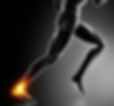Posterior Heel Pain
- Dr. Correa
- Apr 26, 2021
- 4 min read
Updated: Apr 30
In this section Cypress Foot and Ankle specialists Dr. Christopher Correa explores causes and treatments for posterior heel pain and posterior heel spurs. Got a nagging pain the back of your heel? Posterior heel pain can be a seriously inconvenient problem that stops people dead in their tracks. To understand what causes this kind of heel pain let's take a look at the relevant anatomy. The heel bone is known as the Calcaneus which has a rounded posterior body known as the tuber. The tuber is the portion of the bone that allows passive rolling of the foot during the gait cycle contributing to a smooth and energy efficient step. The very back of the heel is where the Achilles Tendon, the largest and strongest tendon in your body, connects (Red arrow).

The muscle that controls the Achilles is known collectively as the calf muscle and it is made up of 2 muscles heads, the Soleus and Gastrocneumius. Together these two muscular components allow you to point and stand on your toes and are primarily responsible for explosive motions such as running and jumping. For more detail on Calf muscle function and how it can contribute to the formation of a posterior heel spur click here. Naturally this connection is massively important for walking and climbing as well and exerts a near constant tension between the bone/tendon interface. Excessive tension can lead to Achilles Tendonitis and reactive bone growth overtime and form of a projection of bone known as a “spur”. Another common place this occurs in the heel bone in on the bottom and is sometimes associated with Plantar Fasciitis. Most of the time when people refer to heel spurs, they are referring to inferior heel spurs. If you want to know more about plantar fasciitis click here. While posterior heel spurs are less often thought of, they are sometimes very painful and in severe cases can lead to Achilles Tendon ruptures if left untreated.
Posterior Heel Spur Pain
The major contributing factor to the formation of posterior heel spurs is a tight calf muscle. This vastly increases the traction stress of the Achilles at the posterior heel and causes spur formation, tendon degeneration and in extreme cases fracturing of a formed spur. Each of these conditions cause varying degrees of posterior heel pain that range from mildly annoying to quite debilitating. The formation of a spur is thanks to a principle known as Wolff’s Law. This law dictates that bone remodeling occurs as a response to the forces that travel through the skeleton. This mechanism is important in strengthening the skeleton and prevents fracturing during exercise or accidents. While many people form spurs at the posterior heel the vast majority of them produce no symptoms. While the presence of a spur does not guarantee that symptoms will ever develop, it is still a good idea to stretch the calf muscle to prevent progression of deformity and degeneration of the Achilles Tendon. When symptoms do occur, they are typically characterized as being worse with the first step out of bed in the morning or after periods of rest. Symptoms may resolve after “walking it off” for a few minutes but tend to worsen over the course of the day and can be quite severe by the end of the day. Visually there will be swelling, redness and an enlarged palpable bump at the back of the heel. Posterior heel spurs are often associated with thickening and damage to the Achilles tendon which also contributes to the enlarged size. As bone spurs increase in size over time they become increasingly at risk for fracturing. A fractured spur usually causes a significant amount of swelling and pain. Immobilization and anti-inflammatories can treat spur fractures but often times when the spur fractures it is necessary to remove the broken portion of bone to alleviate symptoms.
Typically, the spur develops inside the insertion of the tendon, and this grows into the tendon necessitating removal of the spur. Often times spur removal requires a complete detachment of the Achilles Tendon in order the debride the damaged bone and remove any degenerated tendon. One potential complication of posterior heel spurs is excessive degeneration of the Achilles tendon at the insertion leading to rupture. This is known as a sleeve avulsion and occurs when the end of the Achilles tendon completely pulls away from the bone. For these reasons pain at the posterior heel is not something you should ignore.
Treatment for posterior heel spur pain typically starts with conservative options aimed at reducing inflammation and relieving pressure on the affected area. This may include custom orthotics, heel lifts, stretching exercises, anti-inflammatory medications, and physical therapy to address tightness in the Achilles tendon. In more stubborn cases, night splints, immobilization boots, or regenerative therapies like platelet-rich plasma (PRP) or stem cell injections may be recommended. If these measures fail to provide relief, surgical intervention to remove the spur or address tendon involvement may be considered as a last resort. If you are experiencing posterior heel pain, give the experts at Select Foot and Ankle Specialists a call or schedule online and take the first step towards recovery today!

